Looking at attention
ADHD is associated with poor attention control, the markers of which include reduced inhibition and cognitive flexibility. These refer to the capacity to ignore irrelevant or distracting objects, and the ability to disengage attention from one object and focusing on another, respectively. Laboratory tasks designed to measure these cognitive processes typically involve showing an object on a computer screen, along with other distracting objects that are designed to capture participants’ attention.
In our lab, participants’ attention can be observed using an eye-tracker, which allows us to determine the location on the computer screen that is being focused on at any given moment. This is especially useful in infant research as it is unobtrusive and does not require any overt responses from the participant, like pressing buttons or answering questions. During an eye-tracking session, infants are sat either on their parent’s lap or in a highchair, while viewing moving images on a computer screen.
The eye-tracking system, attached below the monitor, records infants’ eye movements while they view the images on the screen.
The eye-tracking system is made up of projectors that shines infrared light (invisible to humans) and cameras that records the reflection of the light on the eyes. This reflection pattern changes slightly as the eyes rotate and move around while looking at different areas of the screen. The eye-tracker is able to use this to calculate the location of focus throughout the session.
A recording of gaze locations being tracked while a participant is looking at a scene
This allows us to collect information such as the pattern of gazes, the amount of time spent looking at specific objects, and even changes in pupil size, which are then used as measures of inhibition and cognitive flexibility.


